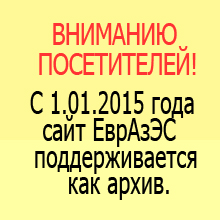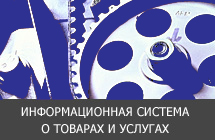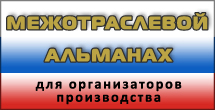|
CONCEPT of cooperation among member states of the Eurasian Economic Community in the monetary sphere Adopted by Resolution of the EurAsEC Interstate Council 22 June 2005, No. 220
CONCEPT of cooperation among member states of the Eurasian Economic Community in the monetary sphere
Cooperation in the monetary sphere between member states of the Eurasian Economic Community (hereinafter referred to as the Parties) is carried out on the basis of the Treaty on the establishment of the Eurasian Economic Community of October 10, 2000 (hereinafter referred to as EurAsEC or the Community) and the Treaty on a customs union and a common economic space of February 26, 1999. Prerequisites for such cooperation are positive results in increased trade and economic interaction, including the abolishment of customs duties with respect to goods produced in the Parties’ territories, establishment of a Unified Customs Tariff and EurAsEC commodity classification for foreign-economic activity, transition to indirect taxation on the “country of destination” principle, adoption of international treaties and resolutions of EurAsEC organs targeted at harmonization of the Parties’ national legislations. Further development of integration processes was reflected in two key documents – “Priority Lines for EurAsEC Development in 2003–2006 and the Subsequent Years” (hereinafter referred to as Priority Lines) and the Action Plan for their implementation (Resolution of EurAsEC Interstate Council (at the level of Heads of State) dated February 9, 2004 No.152).
I. APPRAISAL OF THE PRESENT STAGE
The currency and financial cooperation in the framework of EurAsEC has been recently developing in the following areas: – Phased liberalization of national monetary systems of the Parties was implemented. In particular the corresponding activities were aimed at ensuring the internal convertibility of national currencies, the abolishment of restrictions on the use of other currencies for current payments, introduction of a unified exchange rate for current transactions in the balance of payments, admittance of non-resident banks to the national currency markets, and abolishment of limitations for import and export of national currencies by authorized banks; – Bilateral treaties on mutual convertibility and stabilization of national currencies’ exchange rates, as well as the treaty on elimination of double taxation and the prevention of income and capital tax evasion were signed; – National currency markets where the exchange rate of national currency is formed by supply and demand were created; – The Council of the heads of central (national) banks of EurAsEC member states (hereinafter referred to as the Council) is operational. Since its establishment in February of 2001 the Council has given a considerable boost to currency cooperation and the effectiveness of decisions, speeding up implementation. In particular, the Council has adopted the Long-term Program for Cooperation among Central (National) banks in the Sphere of Currency Regulation and Control (Protocol of November 13, 2003, No.8) (hereinafter referred to as the Long-term Plan) envisaging the step-by-step liberalization of the Parties’ currency legislation; – The Program for Harmonization of Banking Legislation (Resolution of EurAsEC Interstate Council (at the level of Heads of State) of June 18, 2004, No.175) (hereinafter referred to as the Harmonization Program) was agreed and approved. However, EurAsEC is still far from using its integration capacity to the full. Factors hampering the Community’s intensive development are mostly macroeconomic. Among them are insufficient economic development, industrial specialization and cooperation, structural disproportions, the different pace of market reforms carried out by the Parties, and an inefficient mechanism of coordinating the Parties’ interests and putting into practice the agreed arrangements. There are cases of instable exchange rates of national currencies and the subsequent currency risks, a lack of liquid means of payment in the EurAsEC market, polarization of the Parties’ economies and slowness in establishing a payment and clearing system in the national currencies. At present the determining development trends in the Parties’ national economies are acceleration of economic growth, increased mutual trade and investment cooperation, and financial stabilization. Therefore the necessary preconditions for implementing integration plans are now taking shape. II. THE NEED FOR COORDINATED CURRENCY POLICY
2. Bearing in mind accumulated international experience, the Parties appreciate the urgency of developing cooperation mechanisms in the EurAsEC financial area and take into account the principles of monetary integration. The general principle of monetary integration is a phased and consistent movement towards a higher level of integration, to monetary union. The successful implementation of integration processes is at the same time conditioned by the right balance of market liberalization and government regulation. The agreed monetary policy implies evening out excessive exchange rate fluctuations in the national currencies, the minimization of currency risks, improvement of liquidity in the currency market of the Community, the establishment of a payment and clearing system in the national currencies, use of common approaches and methods in the sphere of currency regulation, joint actions to protect the Parties’ national markets from potential crises emanating from international financial markets, and the gradual convergence of national monetary systems. Realization of a coordinated monetary policy brings additional opportunities for putting into practice long-term strategies of trade, economic and investment cooperation and ensuring general macroeconomic stability in the region. Taking the above factors into consideration, the present Concept defines the advisable directions of cooperation in the monetary sphere. When defining these the Parties assume that the degree of monetary policy coordination depends directly on the general macroeconomic situation in each of the Parties.
III. PRINCIPLES AND GOALS OF COORDINATED MONETARY POLICY
3. The principles of coordinated monetary policy are as follows: – voluntarism and equality in the rights and obligations of the Parties participating in joint actions in the monetary sphere – an evolutional approach implying phased and regular joint actions in the monetary sphere – maintaining a balance between the macroeconomic conditions of the Parties and the policy of monetary cooperation at all stages – informational openness implying mutually free access by the Parties to information related to financial, economic and monetary legislation, taking into account the national legal requirements of the Parties, as well as other information open for free access at the Parties’ decision. 4. The goals of the coordinated monetary policy are as follows: – achieving full convertibility of national currencies for current and capital transactions of the balance of payments – reaching agreement on the mechanisms to form mutual exchange rates of national currencies – establishing an integrated EurAsEC currency market – establishing a payment and clearing system with the use of national currencies – transferring to International Accounting Standards – providing the legal entities being the Parties’ residents with national treatment in the financial services markets of the Parties The logical goal of integration processes in the future will be the achievement of all the necessary conditions for introducing a single currency for the Community.
IV. PRIORITY LINES AND MECHANISM OF COOPERATION IN THE MONETARY SPHERE
– developing coordinated approaches to monetary, credit and currency policy and the operating principles of central banks – developing common criteria and a list of macroeconomic indicators subject to convergence – coordinating banking legislation and agreeing common principles for the policy of financial institutions’ supervision and regulation – developing principles and conditions for formation of an integrated currency market, a merger of currency trading systems (currency exchanges) of the Parties into a single electronic trading system – choosing and agreeing between the Parties on the best exchange rate regime, including the limits on mutual currency fluctuations – liberalizing transactions related to the movement of capital – keeping a database of legal acts regulating monetary, currency and stock markets – analyzing the status of the national monetary and currency markets – creating a mechanism of collective financial support for Parties experiencing a critical deficit in the balance of payments – establishing in future interstate organizations to deal with the agreement of approaches by EurAsEC member states to integration cooperation in the currency sphere, or giving these functions to existing organizations 6. The mechanism of coordinating and agreeing the Parties’ policy in the currency and financial sphere envisages permanent interaction between representatives of financial ministries and central banks, it also includes the regular exchange of information, development and realization of the corresponding legal base and improvement of the institutional structure for managing integration processes. The specific instruments of this mechanism are as follows: corresponding bilateral and multilateral treaties within the EurAsEC framework; resolutions of the Council; plans, programs and strategies; arrangements on the legal harmonization of the Parties. Each of the Parties retains the opportunity to join the cooperative mechanisms as soon as its national economy reaches the appropriate level. In case any of the Parties experiences considerable disproportion in the balance of payments or extreme destabilization of the national currency exchange rate the Community shall undertake urgent measures to render assistance in overcoming the crisis situation.
V. STAGES OF COORDINATING THE MONETARY POLICY
7. The transfer to coordinated monetary policy is carried out by stages, taking into account the existing macroeconomic conditions and in line with the Action Plan to implement Priority Lines. The Parties specify and elaborate the scope of tasks for each subsequent stage as soon as the tasks of the previous stage are implemented. 8. The first stage: 2005–2007 The first stage is implemented with the background of steady economic growth, completed creation of a liberalized trade area, eliminated customs barriers and the relative stabilization of the currencies. The first stage envisages the following tasks: – developing methodical approaches to the coordination of a macroeconomic policy of the Parties, agreeing on common indicators describing the situation in the national financial markets; adopting the Procedure of agreement on the main macroeconomic parameters of EurAsEC member states; – converging legislations of the Parties that regulate the markets of financial services; concluding a Treaty on the fundamental principles of the policy in the sphere of currency regulation and currency control on operations related to capital movement; implementing the Activities outlined in the Long-Term Program approved by the Council; – forming the integrated currency market of EurAsEC, concluding a Treaty on cooperation in the organization of an integrated currency market; – undertaking the necessary actions targeted at forming a common payment and clearing system for the national currencies of the Parties; – developing and agreeing on a unified mechanism of exchange rates and interventions by the Parties, concluding a Treaty on the mechanism of setting and agreeing the exchange rates of the national currencies; – carrying out the convergence of banking legislation of the Parties in accordance with the Basel principles of regulation and supervision of bank activities and the Harmonization Program; – coordinating the Parties’ actions in the stock markets in accordance with the Treaty on Cooperation Among EurAsEC Member States in Stock Markets (Resolution of EurAsEC Interstate Council (at the level of Heads of State) of June 18, 2004, No. 174); – taking measures to coordinate the national legislations aimed at fighting money laundering and terrorist financing in accordance with international standards; – improving the structure and instruments of monetary and currency markets; – creating conditions for free access of legal entities being the residents of the Parties to the national financial markets of the Parties in accordance with the Priority Lines, concluding bilateral treaties on the provision of a mutual national regime; – arranging a mutual exchange of information on the status and development prospects of the Parties’ economies, on the legal bases and measures taken by the Parties in the sphere of monetary, credit and currency policy. 9. The second stage: 2007–2010 Macroeconomic prerequisites of the second stage are represented by a substantial increase in the level of economic development of the Parties, a gradual evening of structural disproportion, the prevalence of free-market principles in the Parties’ economies, evening of convergence indicators (inflation level, budget deficit to GDP ratio, state debt to GDP ratio, interest rates). During the second stage the following tasks are envisaged: – agreeing on the quantitative values of macroeconomic indicators describing the degree of convergence of the Parties’ economies, creating a mechanism to control the performance of the agreed macroeconomic indicators; – providing harmonization of financial, banking and currency legislation, as well as the principles of monetary, credit and currency policy carried out by the Parties; – agreeing on mechanisms to coordinate monetary, credit and currency policy by the Parties and collective support of Parties experiencing a critical deficit in the balance of payments. 10. The third stage: starting from 2010 On the basis of a fundamental decision taken by the Parties, a transition to the final stage of monetary integration shall be concluded when the conditions and procedures of introducing the single currency within EurAsEC are agreed. It is assumed that in the third stage the following actions will take place: – creation of a common financial market will be completed and the freedom of any capital transactions will be provided; – the interested Parties that meet the convergence criteria shall take a collective decision on setting a fixed exchange rates regime, and on the conditions, the time frames and procedures of introducing a single currency and establishing a monetary union; – member states of the monetary union shall agree on division of power between the national authorities and EurAsEC interstate organs. In the framework of these arrangements they will delegate a part of their powers to EurAsEC interstate organs.
VI. COORDINATION OF WORK
11. The Integration Committee of EurAsEC in cooperation with the governments and central (national) banks of the Parties provides coordination of activities to implement the present Concept. __________
|
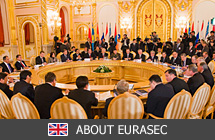
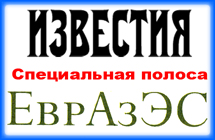
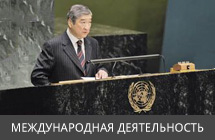

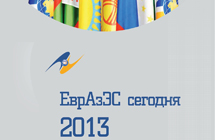
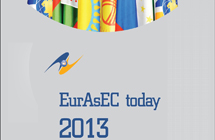
Поиск 10.10.2014 Заседание Межгосударственного совета ЕврАзЭС07.10.2014 Мультимедийная пресс-конференция в агентстве «Россия сегодня»03.10.2014 Встреча с Послом Финляндской Республики04.08.2014 Встреча Генерального секретаря ЕврАзЭС с Послом Республики Таджикистан20.06.2014 Премии Петербургского международного юридического форума «За вклад в развитие правовой интеграции на евразийском пространстве»28.05.2014 Договор о Евразийском экономическом союзе – важнейшее событие в новейшей истории наших стран25.05.2014 Презентация книги «Евразийский проект Нурсултана Назарбаева, воплощенный в жизнь. К 20-летию евразийского проекта 1994–2014»24.05.2014 VII АСТАНИНСКИЙ ЭКОНОМИЧЕСКИЙ ФОРУМ. Панельная сессия «Евразийской экономической интеграции – 20 лет. Итоги и перспективы»24.05.2014 VII Астанинский экономический форум и II Всемирная Антикризисная конференция, 21-23 мая 2014 года, Астана24.05.2014 Петербургский международный экономический форум, 23 – 24 мая 2014 года, Санкт-Петербург |

Евразийское экономическое сообщество
ЕврАзЭС
-
Страны участники
 Беларусь
Беларусь
-
 Казахстан
Казахстан
-
 Кыргызстан
Кыргызстан
-
 Россия
Россия
-
 Таджикистан
Таджикистан
-
 Узбекистан
Узбекистан
-
 Молдова
Молдова
-
 Украина
Украина



